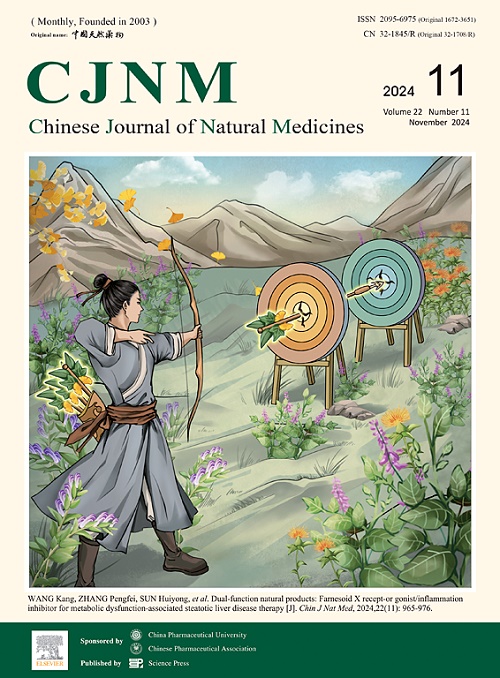梧桐总生物碱通过调节Nrf2/NF-κB/NLRP3信号通路抑制脂多糖诱导的呼吸道炎症
IF 4.9
2区 医学
Q1 INTEGRATIVE & COMPLEMENTARY MEDICINE
引用次数: 0
摘要
炎症在各种疾病的病因和进展中起着关键作用。在传统中医中,全植物为中国梧桐。其制剂(如百瑞颗粒)已被用于治疗炎症。虽然黄酮类化合物以前被认为是主要的抗炎成分,但其他潜在的活性成分在很大程度上被忽视了,也没有得到彻底的研究。本研究提出了一项新发现,即三叶草总生物碱(BC-Alk)是三叶草和百瑞颗粒作为抗炎药在传统和临床应用的有效活性物质。UPLC-MS/MS分析鉴定BC-Alk为喹诺齐嗪类生物碱。采用脂多糖(LPS)致小鼠肺部炎症模型,评价BC-Alk的抗炎作用。结果表明,BC-Alk可显著减轻lps诱导的小鼠肺部炎症,减轻IL-1β和炎症因子(TNF-α)的过量产生,改善小鼠体内肺组织增生。体外机制研究显示BC-Alk上调Nrf2及其下游蛋白NQO1和谷氨酸-胱氨酸连接酶及修饰子亚基(GCLM)的表达,抑制NF-κB磷酸化,抑制NLRP3活化。总之,这些发现表明BC-Alk通过调节Nrf2、NF-κB和NLRP3通路对肺部炎症具有有效的抑制作用。本研究为百瑞颗粒抗炎成分的研究提供了新的思路。本文章由计算机程序翻译,如有差异,请以英文原文为准。
Total alkaloids from Thesium chinense inhibit lipopolysaccharide-induced respiratory inflammation by modulating Nrf2/NF-κB/NLRP3 signaling pathway
Inflammation plays a pivotal role in the etiology and progression of various diseases. In traditional Chinese medicine, the whole plants of Thesium chinense Turcz. and its preparations (e.g. Bairui Granules) have been employed to manage inflammatory conditions. While flavonoids were previously considered the primary anti-inflammatory components, other potentially active constituents have been largely overlooked and not thoroughly investigated. This study presents a novel finding that the total alkaloids of T. chinense (BC-Alk) are potent active substances underlying the traditional and clinical applications of T. chinense and Bairui Granules as anti-inflammatory agents. UPLC-MS/MS analysis identified the composition of BC-Alk as quinolizidine alkaloids. The anti-inflammatory efficacy of BC-Alk was evaluated using a lipopolysaccharide (LPS)-induced lung inflammation model in mice. Results demonstrated that BC-Alk significantly mitigated LPS-induced lung inflammation, attenuated the overproduction of IL-1β and the overproduction of inflammatory factors (TNF-α), and ameliorated lung tissue hyperplasia in mice in vivo. Mechanistic studies in vitro revealed that BC-Alk upregulated the expression of Nrf2 and its downstream proteins NQO1 and glutamate-cystine ligase and modifier subunit (GCLM), inhibited NF-κB phosphorylation, and suppressed NLRP3 activation. Collectively, these findings indicate that BC-Alk exerts potent inhibitory effects against lung inflammation by modulating Nrf2, NF-κB, and NLRP3 pathways. This study provides new insights into the anti-inflammatory constituents of T. chinense and Bairui Granules.
求助全文
通过发布文献求助,成功后即可免费获取论文全文。
去求助
来源期刊

Chinese Journal of Natural Medicines
INTEGRATIVE & COMPLEMENTARY MEDICINE-PHARMACOLOGY & PHARMACY
CiteScore
7.50
自引率
4.30%
发文量
2235
期刊介绍:
The Chinese Journal of Natural Medicines (CJNM), founded and sponsored in May 2003 by China Pharmaceutical University and the Chinese Pharmaceutical Association, is devoted to communication among pharmaceutical and medical scientists interested in the advancement of Traditional Chinese Medicines (TCM). CJNM publishes articles relating to a broad spectrum of bioactive natural products, leading compounds and medicines derived from Traditional Chinese Medicines (TCM).
Topics covered by the journal are: Resources of Traditional Chinese Medicines; Interaction and complexity of prescription; Natural Products Chemistry (including structure modification, semi-and total synthesis, bio-transformation); Pharmacology of natural products and prescription (including pharmacokinetics and toxicology); Pharmaceutics and Analytical Methods of natural products.
 求助内容:
求助内容: 应助结果提醒方式:
应助结果提醒方式:


